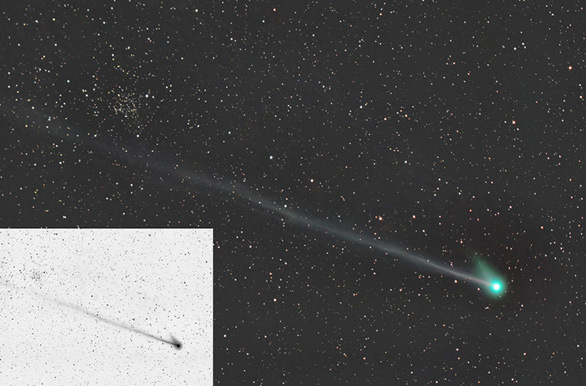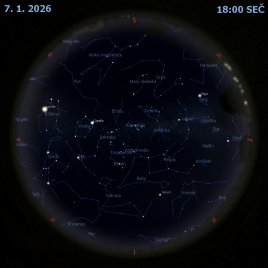Kometa McNaught u NGC 1245

Uznání a copyright: Rich Richins
Jedna z mnoha komet pojmenovaná po svém objeviteli Robertu McNaughtovi katalogizovaná jako C/2009 R1 zdobí pozorovatelům na severní polokouli tento měsíc časnou ranní oblohu. Zde na snímku z 13. června z jižního Nového Mexika je vidět, jak se dlouhý iontový ohon komety McNaught táhne teleskopickým polem (je vložen i negativní snímek). Pozoruhodné je, že iontový ohon se pěkně prostírá před hvězdokupou NGC 1245 (vlevo nahoře) v souhvězdí Persea, asi 1,5 stupně od nádherné zelenavé hlavy neboli komy. Z komy také vyrůstá krátký, tlustý, prachový ohon. Kometa a hvězdy v pozadí se pochopitelně pohybují na pozemské obloze různou rychlostí. Ovšem digitální zpracování mnoha krátkých expozic umožnilo oddělit obrazy komety a hvězd, registrovat je, a rekombinovat do výsledného obrazu. Položte kurzor na obrázek, a uvidíte kometu bez hvězd pozadí. Rekombinované snímky ukazují jak pole bohaté na hvězdy, tak slabé detaily komety. Kometu McNaught lze nyní snadno uvidět i triedrem, ale v nadcházejících dnech se bude na východním obzoru nořit do svítání, jelikož se blíží k perihelu (největšímu přiblížení ke Slunci) 2. července.
NASA Official: Phillip Newman Specific rights apply. NASA Web Privacy Policy and Important Notices
A service of: ASD at NASA / GSFC & Michigan Tech. U.
Odkaz na originální APOD


